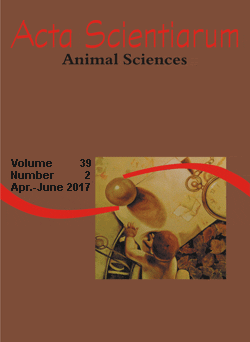<b>Underwater structures for periphyton in bioflocs tanks for Nile tilapia submitted to feed restriction
Resumo
The objective of the present work was to assess the possible benefits of the installation of underwater structures for periphyton in bioflocs tanks for Nile tilapia, Oreochromis niloticus, submitted to feed restriction (artificial diet). The experimental treatments evaluated were: (1) BFT: bioflocs technology for aquaculture with no feed restriction; (2) BFT-30: the same as (1) but with feed restriction at 30%; (3) BP: biophyton technology for aquaculture, that is, integration between bioflocs and periphyton in the same rearing unit, with no feed restriction; (4) BP-30: the same as (3) but with feed restriction at 30%. The underwater structures for periphyton in the BP and BP-30 tanks were not able to reduce the concentrations of ammonia, nitrite, nitrate and reactive phosphorus in the water to same respective level found in the BFT and BFT-30 tanks. The underwater structures for periphyton in the BP and BP-30 tanks have not significantly affected fish growth performance. No benefits were obtained by the installation of underwater structures for periphyton in bioflocs tanks submitted to feed restriction on water quality, water microbiology and tilapia growth performance.
Downloads
DECLARAÇÃO DE ORIGINALIDADE E DIREITOS AUTORAIS
Declaro que o presente artigo é original, não tendo sido submetido à publicação em qualquer outro periódico nacional ou internacional, quer seja em parte ou em sua totalidade.
Os direitos autorais pertencem exclusivamente aos autores. Os direitos de licenciamento utilizados pelo periódico é a licença Creative Commons Attribution 4.0 (CC BY 4.0): são permitidos o compartilhamento (cópia e distribuição do material em qualqer meio ou formato) e adaptação (remix, transformação e criação de material a partir do conteúdo assim licenciado para quaisquer fins, inclusive comerciais.
Recomenda-se a leitura desse link para maiores informações sobre o tema: fornecimento de créditos e referências de forma correta, entre outros detalhes cruciais para uso adequado do material licenciado.








































